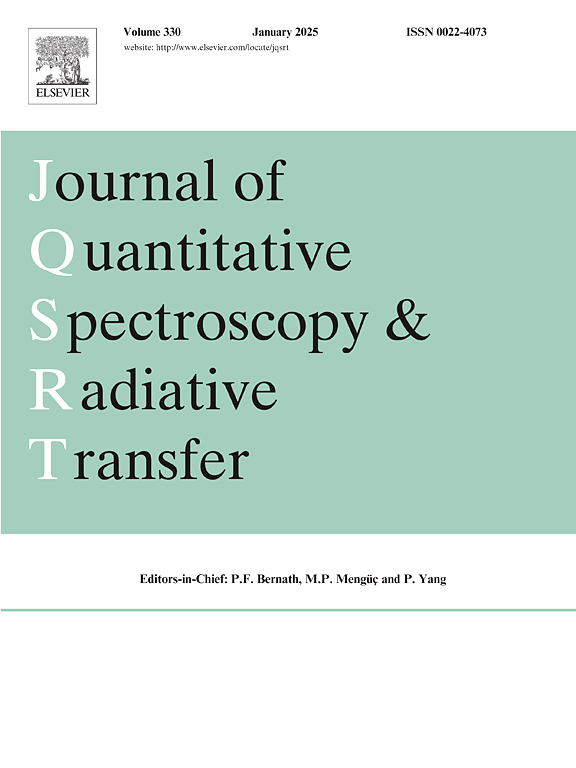Using hybrid deep learning to predict spectral responses of quantum dot-embedded nanoporous thin-film solar cells
IF 2.3
3区 物理与天体物理
Q2 OPTICS
Journal of Quantitative Spectroscopy & Radiative Transfer
Pub Date : 2024-11-05
DOI:10.1016/j.jqsrt.2024.109258
引用次数: 0
Abstract
In this study, we propose an innovative design for nanoporous Si thin film (NPTF) solar cell, seamlessly integrated with semiconducting (CdSe)ZnS Quantum Dots (QDs), without the need for additional metal-dielectric interfaces to attain plasmonic like effects. The intricate network of randomized nano-scaled pores within thin film creates similar enhancement, complemented by QDs inducing excitonic resonances, and amplifying localized electromagnetic field density. To evaluate the spectral responses of the structure we use a supervised trained surrogate model. To train the model, we generate ground truth datasets by solving Maxwell's equations in the design domain and, subsequently, applying charge carrier dynamics model to evaluate the external quantum efficiency (EQE). To predict the spectral response for this stochastic design with randomized pore and QD positions, we feed the ground truth data to a customized Hybrid Deep Learning (HDL) model through in-vitro geometric features fused with dynamic features of QDs. The dynamic features are extracted using an electron dynamics (ED) study. We then evaluate the prediction accuracy of our HDL model. Results show that our designed model can predict absorptivity with an accuracy of R2 > 0.96, and EQE with an accuracy of R2 > 0.98. This investigation highlights the potential of coupling nanoporous thin film solar cells with QDs, an observed localized enhancement phenomenon, and HDL model to achieve high-performance thin-film solar cells, characterized by improved external quantum efficiency without using metal-dielectric interfaces.
利用混合深度学习预测量子点嵌入式纳米多孔薄膜太阳能电池的光谱响应
在这项研究中,我们提出了一种创新的纳米多孔硅薄膜(NPTF)太阳能电池设计方案,该方案与半导体(硒化镉)锌量子点(QDs)无缝集成,无需额外的金属-电介质界面即可实现类似等离子体的效果。薄膜中错综复杂的随机纳米级孔隙网络也产生了类似的增强效果,而 QDs 则可诱发激子共振,并放大局部电磁场密度。为了评估该结构的光谱响应,我们使用了一个经过监督训练的代理模型。为了训练模型,我们通过求解设计域中的麦克斯韦方程来生成基本真实数据集,然后应用电荷载流子动力学模型来评估外部量子效率(EQE)。为了预测这种具有随机孔隙和 QD 位置的随机设计的光谱响应,我们通过体外几何特征与 QD 动态特征的融合,将地面实况数据输入定制的混合深度学习 (HDL) 模型。动态特征是通过电子动力学(ED)研究提取的。然后,我们评估了 HDL 模型的预测准确性。结果表明,我们设计的模型预测吸收率的准确度为 R2 > 0.96,预测 EQE 的准确度为 R2 > 0.98。这项研究凸显了将纳米多孔薄膜太阳能电池与 QDs、观测到的局部增强现象和 HDL 模型结合起来的潜力,从而实现高性能薄膜太阳能电池,其特点是无需使用金属-电介质界面即可提高外部量子效率。
本文章由计算机程序翻译,如有差异,请以英文原文为准。
求助全文
约1分钟内获得全文
求助全文
来源期刊
CiteScore
5.30
自引率
21.70%
发文量
273
审稿时长
58 days
期刊介绍:
Papers with the following subject areas are suitable for publication in the Journal of Quantitative Spectroscopy and Radiative Transfer:
- Theoretical and experimental aspects of the spectra of atoms, molecules, ions, and plasmas.
- Spectral lineshape studies including models and computational algorithms.
- Atmospheric spectroscopy.
- Theoretical and experimental aspects of light scattering.
- Application of light scattering in particle characterization and remote sensing.
- Application of light scattering in biological sciences and medicine.
- Radiative transfer in absorbing, emitting, and scattering media.
- Radiative transfer in stochastic media.

 求助内容:
求助内容: 应助结果提醒方式:
应助结果提醒方式:


